Novel Therapeutic Approach in PEGylated Chitosan Nanoparticles of Apigenin for the Treatment of Cancer via Oral Nanomedicine
Abstract
1. Introduction
2. Methods and Materials
2.1. Materials
2.2. Preparation of APG-Loaded PEGylated Chitosan Nanoparticles (PEGylated-CNPs)
2.3. Experimental Design
3. Physicochemical Characterization of APG-Loaded PEGylated-CNPs
3.1. PS, and ZP Analysis
3.2. Determination of DEE (Drug Entrapment Efficiency) and Loading Capacity (LC)
3.3. Transmission Electron Microscope (TEM) Analysis
3.4. In Vitro Drug Release
3.5. Storage and pH Stability Studies
3.6. Determination of Antioxidant Potential of Optimized APG-Loaded PEGylated-CNPs
3.7. Cytotoxicity Study
3.8. Statistical Analysis
4. Results and Discussion
4.1. Designed Experiment Statistical Analysis
4.2. Evaluation of Response Surface with Polynomial Equation
4.3. Response 1 (Y1): Effect of Investigated Independent Variables on PS
4.4. Response 2 (Y2): Effect of Independent Variables on % DEE
4.5. Response 3 (Y3): Effect of Investigated Independent Factors on ZP
4.6. Formulation Optimization for the APG-PEGylated CNPs
4.7. Characterization of Optimized APG-PEGylated CNPs
4.8. In Vitro Dissolution Studies
4.9. Storage and pH-Dependent Stability Studies
4.10. In Vitro Antioxidant Activity: DPPH Assay
4.11. Cytotoxicity Study
5. Conclusions
Author Contributions
Funding
Institutional Review Board Statement
Informed Consent Statement
Data Availability Statement
Acknowledgments
Conflicts of Interest
References
- Mujtaba, M.A.; Akhter, M.H.; Alam, M.S.; Ali, M.D.; Hussain, A. An updated review on therapeutic potential and recent advances in drug delivery of Berberine: Current status and future prospect. Curr. Pharm. Biotechnol. 2022, 23, 60–71. [Google Scholar] [CrossRef] [PubMed]
- Wang, M.; Firrman, J.; Liu, L.; Yam, K. A Review on Flavonoid Apigenin: Dietary Intake, ADME, Antimicrobial Effects, and Interactions with Human Gut Microbiota. BioMed Res. Int. 2019, 7010467. [Google Scholar] [CrossRef] [PubMed]
- George, V.C.; Dellaire, G.; Rupasinghe, H.P.V. Plant flavonoids in cancer chemoprevention: Role in genome stability. J. Nutr. Biochem. 2017, 45, 1–14. [Google Scholar] [CrossRef] [PubMed]
- Bhattacharya, S.; Mondal, L.; Mukherjee, B.; Dutta, L.; Ehsan, I.; Debnath, M.C.; Gaonkar, R.H.; Pal, M.M.; Majumdar, S. Apigenin loaded nanoparticle delayed development of hepatocellular carcinoma in rats. Nanomedicine 2018, 14, 1905–1917. [Google Scholar] [CrossRef] [PubMed]
- Salehi, B.; Venditti, A.; Sharifi-Rad, M.; Kręgiel, D.; Sharifi-Rad, J.; Durazzo, A.; Lucarini, M.; Santini, A.; Souto, E.B.; Novellino, E.; et al. The Therapeutic Potential of Apigenin. Int. J. Mol. Sci. 2019, 20, 1305. [Google Scholar] [CrossRef] [PubMed]
- Truzzi, F.; Tibaldi, C.; Zhang, Y.; Dinelli, G.; D’Amen, E. An Overview on Dietary Polyphenols and Their Biopharmaceutical Classification System (BCS). Int. J. Mol. Sci. 2021, 22, 5514. [Google Scholar] [CrossRef] [PubMed]
- Ding, S.M.; Zhang, Z.H.; Song, J.; Cheng, X.D.; Jiang, J.; Jia, X.B. Enhanced bioavailability of apigenin via preparation of a carbon nanopowder solid dispersion. Int. J. Nanomed. 2014, 9, 2327–2333. [Google Scholar] [CrossRef] [PubMed]
- Agrawal, S.; Ahmad, H.; Dwivedi, M.; Shukla, M.; Arya, A.; Sharma, K.; Lal, J.; Dwivedi, A.K. PEGylated chitosan nanoparticles potentiate repurposing of ormeloxifene in breast cancer therapy. Nanomedicine 2016, 11, 2147–2169. [Google Scholar] [CrossRef] [PubMed]
- Mohammed, M.A.; Syeda, J.; Wasan, K.M.; Wasan, E.K. An Overview of chitosan nanoparticles and its application in non-parenteral drug delivery. Pharmaceutics 2017, 9, 53. [Google Scholar] [CrossRef]
- Suk, J.S.; Xu, Q.; Kim, N.; Hanes, J.; Ensign, L.M. PEGylation as a strategy for improving nanoparticle-based drug and gene delivery. Adv. Drug Deliv. Rev. 2016, 99 Pt A, 28–51. [Google Scholar] [CrossRef] [PubMed]
- Alalaiwe, A.; Roberts, G.; Carpinone, P.; Munson, J.; Roberts, S. Influence of PEG coating on the oral bioavailability of gold nanoparticles in rats. Drug Deliv. 2017, 24, 591–598. [Google Scholar] [CrossRef]
- Hinkley, G.K.; Carpinone, P.; Munson, J.W.; Powers, K.W.; Roberts, S.M. Oral absorption of PEG-coated versus uncoated gold nanospheres: Does agglomeration matter? Part. Fibre. Toxicol. 2015, 12, 9. [Google Scholar] [CrossRef] [PubMed]
- Chen, J.; Huang, L.; Lai, H.; Lu, C.; Fang, M.; Zhang, Q.; Luo, X. Methotrexate-loaded PEGylated chitosan nanoparticles: Synthesis, characterization, and in vitro and in vivo antitumoral activity. Mol. Pharm. 2014, 11, 2213–2223. [Google Scholar] [CrossRef] [PubMed]
- Rampino, A.; Borgogna, M.; Blasi, P.; Bellich, B.; Cesàro, A. Chitosan nanoparticles: Preparation, size evolution and stability. Int. J. Pharm. 2013, 455, 219–228. [Google Scholar] [CrossRef] [PubMed]
- Hirpara, M.R.; Manikkath, J.; Sivakumar, K.; Managuli, R.S.; Gourishetti, K.; Krishnadas, N.; Shenoy, R.R.; Jayaprakash, B.; Rao, C.M.; Mutalik, S. Long circulating PEGylated-chitosan nanoparticles of rosuvastatin calcium: Development and in vitro and in vivo evaluations. Int. J. Biol. Macromol. 2018, 107 Pt B, 2190–2200. [Google Scholar] [CrossRef] [PubMed]
- Mujtaba, M.A. Development of Apigenin-Loaded Niosomes Using Ecological Probe Sonication Technique for enhanced oral delivery: Application of Box-Behnken Design. Curr. Pharm. Biotechnol. 2022, 23, 882–893. [Google Scholar] [CrossRef] [PubMed]
- Yadav, P.; Rastogi, V.; Verma, A. Application of Box–Behnken design and desirability function in the development and optimization of self-nanoemulsifying drug delivery system for enhanced dissolution of ezetimibe. Futur. J. Pharm. Sci. 2020, 6, 7. [Google Scholar] [CrossRef]
- Abosabaa, S.A.; ElMeshad, A.N.; Arafa, M.G. Chitosan Nanocarrier Entrapping Hydrophilic Drugs as Advanced Polymeric System for Dual Pharmaceutical and Cosmeceutical Application: A Comprehensive Analysis Using Box-Behnken Design. Polymers 2021, 13, 677. [Google Scholar] [CrossRef] [PubMed]
- Khan, N.; Alruwaili, N.K.; Bukhari, S.N.A.; Alsuwayt, B.; Afzal, M.; Akhter, S.; Yasir, M.; Elmowafy, M.; Shalaby, K.; Ali, A. Improvement of Ocular Efficacy of Levofloxacin by Bioadhesive Chitosan Coated PLGA Nanoparticles: Box-behnken Design, In-vitro Characterization, Antibacterial Evaluation and Scintigraphy Study. Antibact. Eval. Scintigr. Study Iran. J. Pharm. Res. 2020, 19, 292–311. [Google Scholar]
- Soni, K.; Mujtaba, A.; Akhter, M.H.; Zafar, A.; Kohli, K. Optimisation of ethosomal nanogel for topical nano-cur and sulphoraphane delivery in effective skin cancer therapy. J. Microencapsul. 2020, 37, 91–108. [Google Scholar] [CrossRef]
- Kohli, K.; Mujtaba, A.; Malik, R.; Amin, S.; Alam, M.S.; Ali, A.; Barkat, M.A.; Ansari, M.J. Development of natural polysaccharide-based nanoparticles of berberine to enhance oral bioavailability: Formulation, optimization, ex vivo, and in vivo assessment. Polymers 2021, 13, 3833. [Google Scholar] [CrossRef]
- Das, S.; Das, J.; Samadder, A.; Paul, A.; Khuda-Bukhsh, A.R. Efficacy of PLGA-loaded apigenin nanoparticles in Benzo[a]pyrene and ultraviolet-B induced skin cancer of mice: Mitochondria mediated apoptotic signalling cascades. Food Chem. Toxicol. 2013, 62, 670–680. [Google Scholar] [CrossRef]
- Telange, D.R.; Patil, A.T.; Pethe, A.M.; Fegade, H.; Anand, S.; Dave, V.S. Formulation and characterization of an apigenin-phospholipid phytosome (APLC) for improved solubility, in vivo bioavailability, and antioxidant potential. Eur. J. Pharm. Sci. 2017, 108, 36–49. [Google Scholar] [CrossRef] [PubMed]
- Gilani, S.J.; Bin-Jumah, M.; Rizwanullah, M.; Imam, S.S.; Imtiyaz, K.; Alshehri, S.; Rizvi, M.M.A. Chitosan coated luteolin nanostructured lipid carriers: Optimization, in vitro-ex vivo assessments and cytotoxicity study in breast cancer cells. Coatings 2021, 11, 158. [Google Scholar] [CrossRef]
- Alshehri, S.; Imam, S.S.; Rizwanullah, M.; Fakhri, K.U.; Rizvi, M.; Alam, M.; Mahdi, W.; Kazi, M. Effect of chitosan coating on plga nanoparticles for oral delivery of thymoquinone: In vitro, ex vivo, and cancer cell line assessments. Coatings 2021, 11, e6. [Google Scholar] [CrossRef]
- Chung, Y.-I.; Kim, J.C.; Kim, Y.H.; Tae, G.; Lee, S.-Y.; Kim, K.; Kwon, I.C. The effect of surface functionalization of PLGA nanoparticles by heparin-or chitosan-conjugated Pluronic on tumor targeting. J. Control. Release 2010, 143, 374–382. [Google Scholar] [CrossRef] [PubMed]
- Fröhlich, E. The role of surface charge in cellular uptake and cytotoxicity of medical nanoparticles. Int. J. Nanomed. 2012, 7, 5577–5591. [Google Scholar] [CrossRef]
- Yue, Z.-G.; Wei, W.; Lv, P.-P.; Yue, H.; Wang, L.-Y.; Su, Z.-G.; Ma, G.-H. Surface charge affects cellular uptake and intracellular trafficking of chitosan-based nanoparticles. Biomacromolecules 2011, 12, 2440–2446. [Google Scholar] [CrossRef]
- Chandra Hembram, K.; Prabha, S.; Chandra, R.; Ahmed, B.; Nimesh, S. Advances in preparation and characterization of chitosan nanoparticles for therapeutics. Artif. Cells Nanomed. Biotechnol. 2016, 44, 305–314. [Google Scholar] [CrossRef] [PubMed]
- Adena, S.K.R.; Upadhyay, M.; Vardhan, H.; Mishra, B. Development, optimization, and in vitro characterization of dasatinib-loaded PEG functionalized chitosan capped gold nanoparticles using Box-Behnken experimental design. Drug Dev. Ind. Pharm. 2018, 44, 493–501. [Google Scholar] [CrossRef] [PubMed]
- Hassani Najafabadi, A.; Abdouss, M.; Faghihi, S. Synthesis and evaluation of PEG-O-chitosan nanoparticles for delivery of poor water soluble drugs: Ibuprofen. Mater. Sci. Eng. C Mater. Biol. Appl. 2014, 41, 91–99. [Google Scholar] [CrossRef] [PubMed]
- Caddeo, C.; Pucci, L.; Gabriele, M.; Carbone, C.; Fernàndez-Busquets, X.; Valenti, D.; Pons, R.; Vassallo, A.; Fadda, A.M.; Manconi, M. Stability, biocompatibility and antioxidant activity of PEG-modified liposomes containing resveratrol. Int. J. Pharm. 2018, 538, 40–47. [Google Scholar] [CrossRef] [PubMed]
- Anraku, M.; Hiraga, A.; Iohara, D.; Uekama, K.; Tomida, H.; Otagiri, M.; Hirayama, F. Preparation and antioxidant activity of PEGylated chitosans with different particle sizes. Int. J. Biol. Macromol. 2014, 70, 64–69. [Google Scholar] [CrossRef] [PubMed]
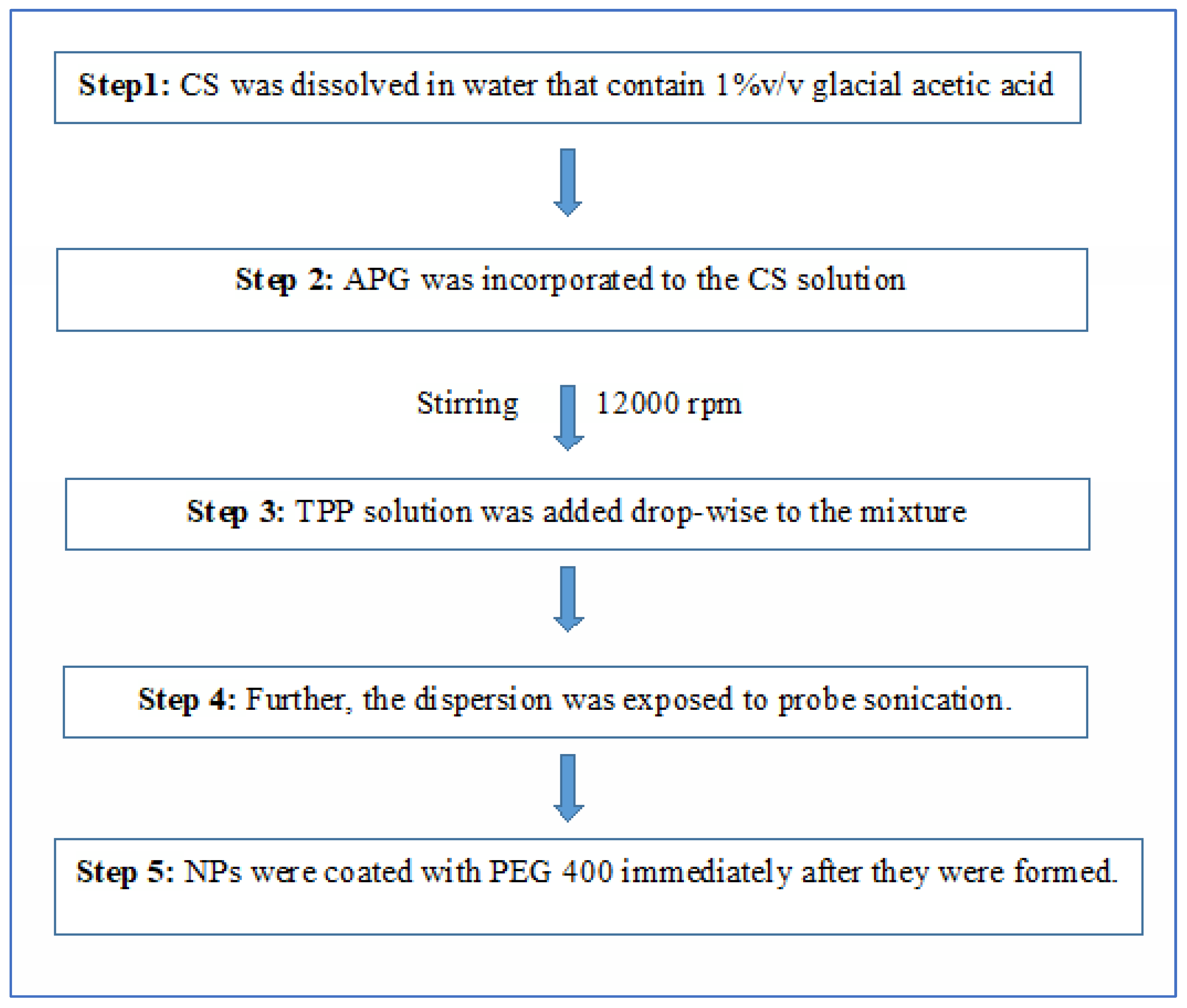



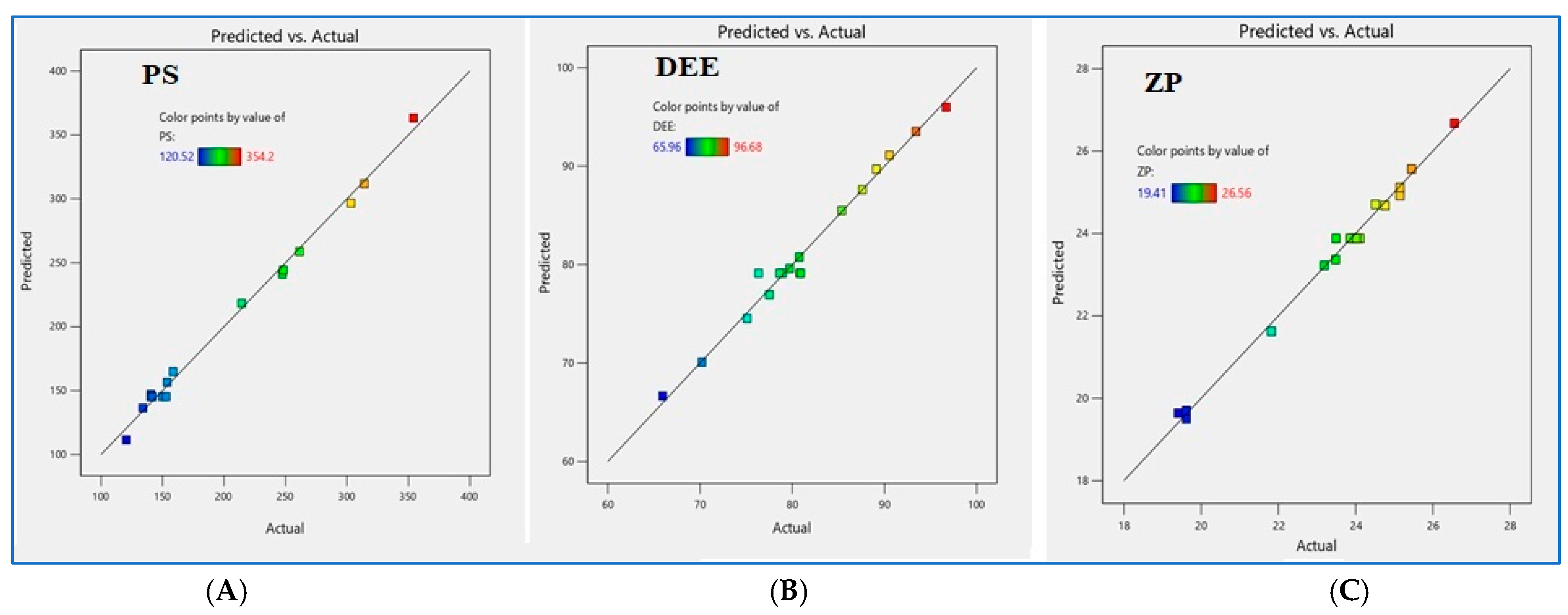
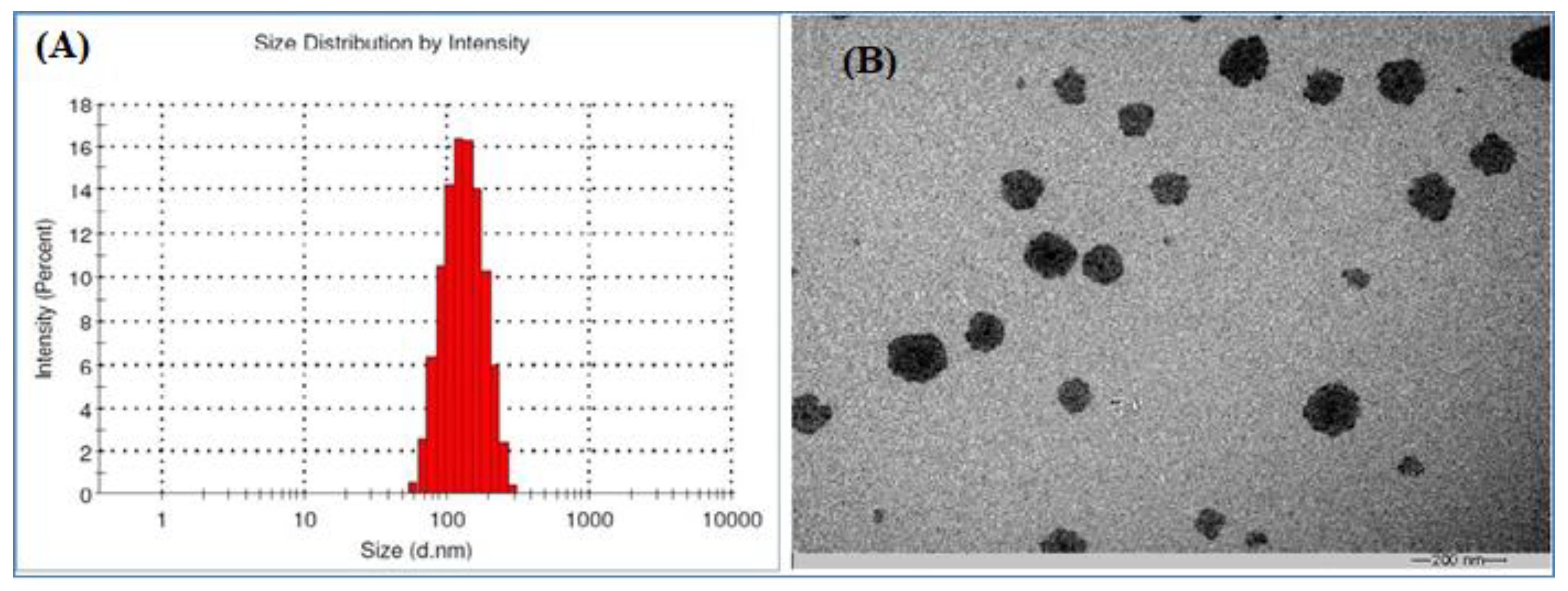
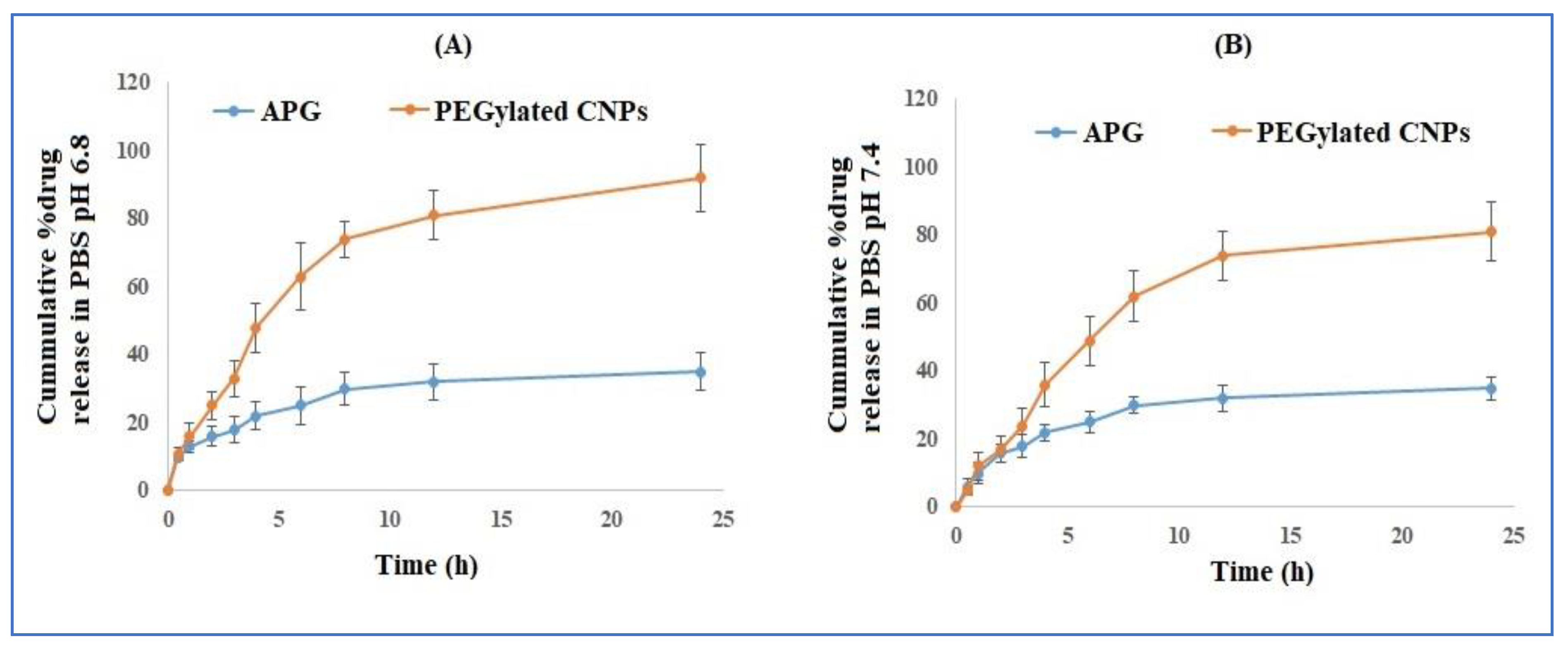
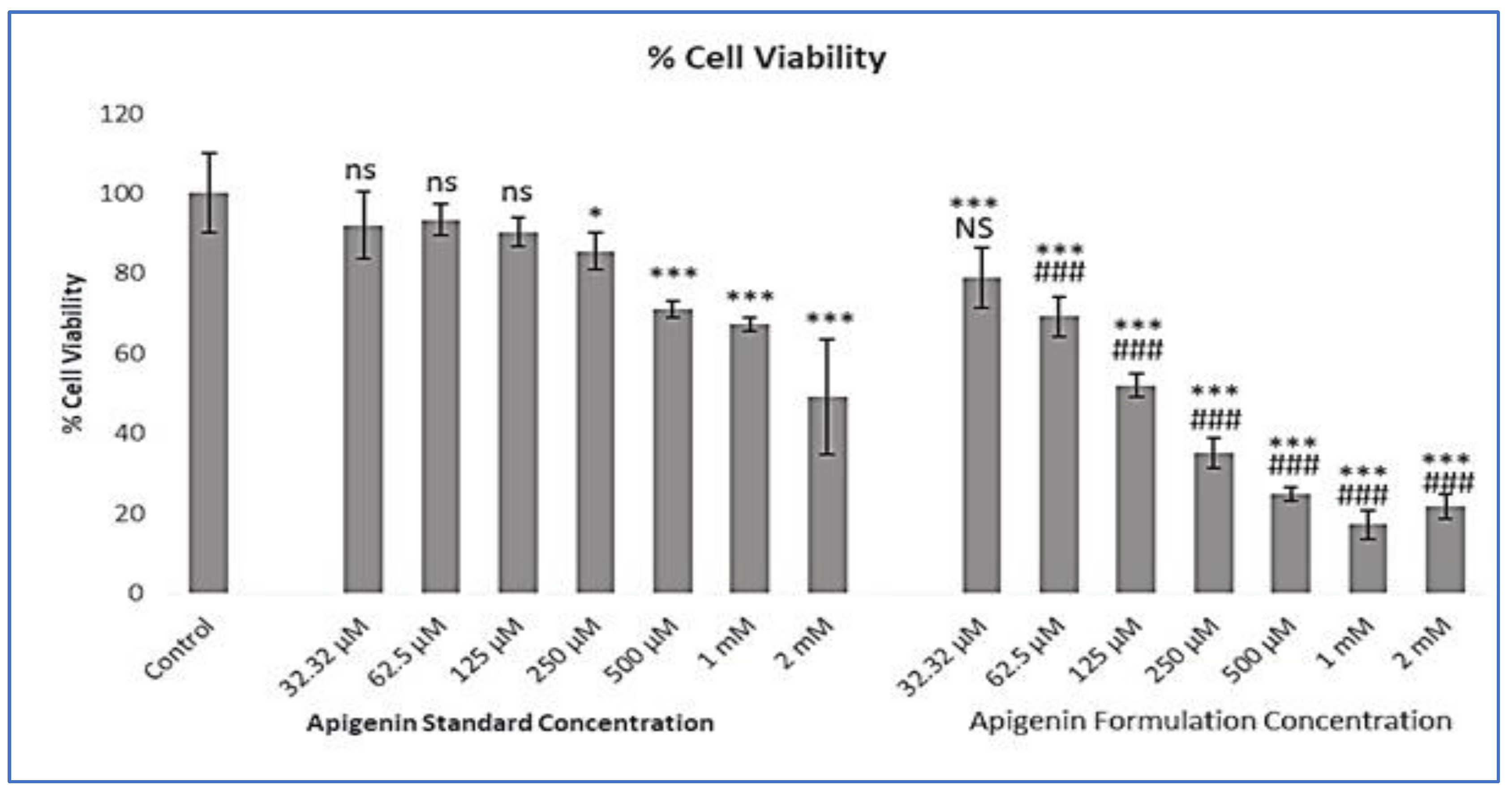
| Variable | Levels | ||
|---|---|---|---|
| −1 | 0 | +1 | |
| Independent variables | |||
| X1 = CS: TPP (% w/w) | 0.2 | 0.5 | 0.8 |
| X2 = PEG 400 (% w/w) | 0.5 | 0.75 | 1 |
| X3 = Sonication time (minutes) | 10 | 20 | 30 |
| Dependent variables | |||
| Y1 = Particle size (nm) | |||
| Y2 = Entrapment efficiency (%) | |||
| Y3 = Zeta potential (mV) | |||
| Formulation Code | Factors Combinations at Different Levels | Response Variables | ||||
|---|---|---|---|---|---|---|
| X1 = Chitosan: TPP | X2 = PEG 400 | X3 = Sonication Time | Y1 = Particle Size (nm) | Y2 = Entrapment Efficiency (%) | Y3 = Zeta Potential (mV) | |
| CNP 1 | 0.2 | 0.5 | 20 | 140.52 | 75.11 | 19.62 |
| CNP 2 | 0.8 | 0.5 | 20 | 247.5 | 85.37 | 24.51 |
| CNP 3 | 0.2 | 1 | 20 | 158.6 | 79.72 | 21.82 |
| CNP 4 | 0.8 | 1 | 20 | 303.3 | 90.54 | 26.56 |
| CNP 5 | 0.2 | 0.75 | 10 | 248.3 | 87.61 | 19.41 |
| CNP 6 | 0.8 | 0.75 | 10 | 354.2 | 96.68 | 24.76 |
| CNP 7 | 0.2 | 0.75 | 30 | 120.52 | 65.96 | 19.62 |
| CNP 8 | 0.8 | 0.75 | 30 | 214.4 | 80.76 | 25.15 |
| CNP 9 | 0.5 | 0.5 | 10 | 261.5 | 89.12 | 23.48 |
| CNP 10 | 0.5 | 1 | 10 | 314.2 | 93.41 | 25.15 |
| CNP 11 | 0.5 | 0.5 | 30 | 134.1 | 70.21 | 23.19 |
| CNP 12 | 0.5 | 1 | 30 | 153.8 | 77.52 | 25.45 |
| CNP 13 | 0.5 | 0.75 | 20 | 141.2 | 76.35 | 23.49 |
| CNP 14 | 0.5 | 0.75 | 20 | 150.1 | 80.82 | 23.92 |
| CNP 15 | 0.5 | 0.75 | 20 | 153.1 | 80.91 | 24.11 |
| Model | R2 | Adjusted R2 | %C.V | S.D | PRESS | Remarks |
|---|---|---|---|---|---|---|
| Response: Particle size (Y1) | ||||||
| Linear model | 0.7481 | 0.6899 | - | 41.57 | 33,163.03 | - |
| Quadratic model | 0.9941 | 0.9865 | 4.36 | 8.66 | 6423.28 | Suggested |
| Cubic model | 0.9985 | 0.9939 | 5.85 | ND | - | |
| Response: Entrapment efficiency (%) (Y2) | ||||||
| Linear model | 0.9312 | 0.9153 | - | 2.34 | 105.50 | - |
| Quadratic model | 0.9842 | 0.9638 | 1.87 | 1.53 | 59.49 | Suggested |
| Cubic model | 0.9864 | 0.9457 | - | 1.87 | ND | - |
| Response: Zeta potential (mV) (Y3) | ||||||
| Linear model | 0.8494 | 0.8146 | - | 0.9122 | 21.40 | - |
| Quadratic model | 0.9933 | 0.9848 | 1.12 | 0.2614 | 4.38 | Suggested |
| Cubic model | 0.9968 | 0.9874 | - | 0.2380 | ND | - |
| Quadratic Model | |||||||
|---|---|---|---|---|---|---|---|
| Response | F-Value | p-Value | R2 | Adjusted R2 | Predicted R2 | Lack of Fit | Remarks |
| PS | 131.32 | <0.0001 | 0.9941 | 0.9865 | 0.9280 | 0.1159 | Significant |
| EE | 48.35 | <0.0001 | 0.9842 | 0.9638 | 0.9426 | 0.8763 | Significant |
| ZP | 116.01 | <0.0001 | 0.9933 | 0.9848 | 0.9390 | 0.3471 | Significant |
| Independent Variables for Response Optimization | ||
| A- Chitosan: TPP (% w/w) | 0.50 | |
| B- PEG 400 (% w/w) | 0.75 | |
| C- Sonication time (minutes) | 20 | |
| Optimized results | ||
| Dependent variables (responses) | Predicted value | Experimental value a |
| Y1 = Particle size (nm) | 145.32 | 139.63 ± 5.67 |
| Y2 = Entrapment efficiency (%) | 79.12 | 79.55 ± 3.12 |
| Y3 = Zeta potential (mV) | 23.88 | 24.68 ± 1.84 |
| CNPs Formulation (5±2°C) | |||
| Time (Days) | Particle Size ± SD nm | PDI | Zeta Potential (mV) |
| Initial 30 60 90 | 139.63 ± 5.74 141.51 ± 7.65 142.19 ± 6.21 142.92 ± 7.58 | 0.296 ± 0.02 0.294 ± 0.03 0.306 ± 0.03 0.316 ± 0.04 | 24.68 ± 1.84 24.89 ± 1.96 23.76 ± 2.67 24.13 ± 2.39 |
| CNPs formulation (25±2°C) | |||
| Initial 30 60 90 | 139.63 ± 5.74 142.45 ± 6.24 142.98 ± 7.12 143.12 ± 7.28 | 0.296 ± 0.02 0.301 ± 0.03 0.307 ± 0.04 0.310 ± 0.04 | 24.68 ± 1.84 23.97 ± 1.88 24.69 ± 2.25 24.13 ± 2.23 |
| Stability at different pH conditions (incubation for 24 h) | |||
| pH condition | Particle size ± SD nm | PDI | Zeta potential (mV) |
| pH 6.8 | 138.39 ± 6.14 | 0.299 ± 0.03 | 23.98 ± 1.88 |
| pH 7.4 | 143.23 ± 7.05 | 0.303 ± 0.03 | 24.56 ± 2.08 |
| AA (%) | |
|---|---|
| Pure APG suspension | 67.94 ± 4.2 |
| APG loaded PEGylated CNPs | 74.11 ± 5.6 |
| PEGylated CNPs (Blank) | 13.8 ± 3.1 |
Publisher’s Note: MDPI stays neutral with regard to jurisdictional claims in published maps and institutional affiliations. |
© 2022 by the authors. Licensee MDPI, Basel, Switzerland. This article is an open access article distributed under the terms and conditions of the Creative Commons Attribution (CC BY) license (https://creativecommons.org/licenses/by/4.0/).
Share and Cite
Mujtaba, M.A.; Alotaibi, N.M.; Alshehri, S.M.; Yusuf, M.; Anwer, M.K.; Rahman, M.A.; Parveen, A. Novel Therapeutic Approach in PEGylated Chitosan Nanoparticles of Apigenin for the Treatment of Cancer via Oral Nanomedicine. Polymers 2022, 14, 4344. https://doi.org/10.3390/polym14204344
Mujtaba MA, Alotaibi NM, Alshehri SM, Yusuf M, Anwer MK, Rahman MA, Parveen A. Novel Therapeutic Approach in PEGylated Chitosan Nanoparticles of Apigenin for the Treatment of Cancer via Oral Nanomedicine. Polymers. 2022; 14(20):4344. https://doi.org/10.3390/polym14204344
Chicago/Turabian StyleMujtaba, Md Ali, Nawaf M. Alotaibi, Sultan M. Alshehri, Mohammad Yusuf, Md Khalid Anwer, Mohammad Akhlaquer Rahman, and Arshiya Parveen. 2022. "Novel Therapeutic Approach in PEGylated Chitosan Nanoparticles of Apigenin for the Treatment of Cancer via Oral Nanomedicine" Polymers 14, no. 20: 4344. https://doi.org/10.3390/polym14204344
APA StyleMujtaba, M. A., Alotaibi, N. M., Alshehri, S. M., Yusuf, M., Anwer, M. K., Rahman, M. A., & Parveen, A. (2022). Novel Therapeutic Approach in PEGylated Chitosan Nanoparticles of Apigenin for the Treatment of Cancer via Oral Nanomedicine. Polymers, 14(20), 4344. https://doi.org/10.3390/polym14204344







